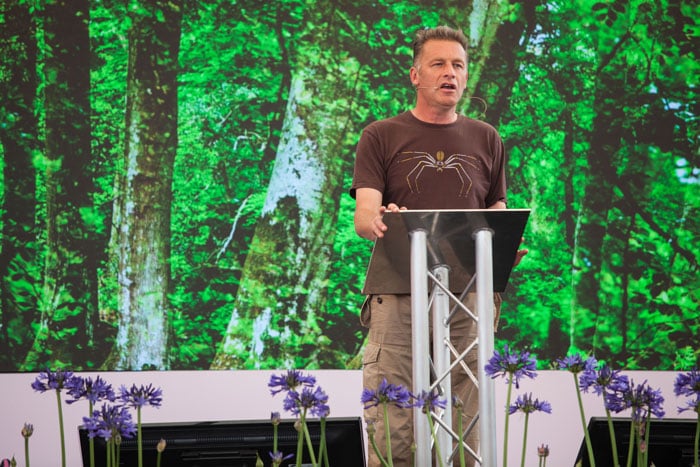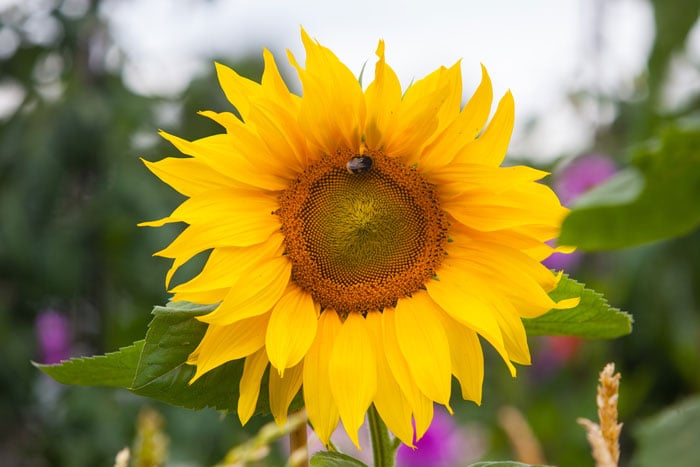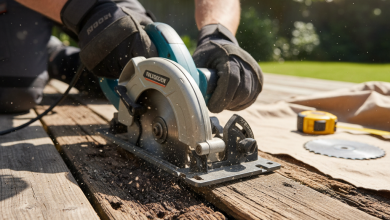We were lucky enough to catch TV presenter and naturalist, Chris Packham, talking at the Hampton Court Flower Show about the UK conservation crisis. Here’s what you can do to help.

Chris Packham is a keen naturalist, well known for his love of conservation, photography, writing… and foxes! He’s the first to admit he’s not an expert gardener, but his knowledge of building balanced ecosystems and his respect for all animals – no matter how small they might be or how many legs they may have – is invaluable to help gardeners with building a strong, sustainable and flourishing outdoor space. Take advantage of his expert insight and learn how to shape your garden for the best results.
Create a varied physical structure
Most of our gardens are what’s considered “marginal habitats”, which mean they offer some of the qualities of a natural woodland habitat, but obviously not all. Very few gardens are entirely flat and most will be more than just lawn. By nature this makes them complex physical structures which offer a variety of surfaces and textures.
When planning your garden, it’s important to think about how your space is catering for wildlife; your lawn might be a rich buffet of earthworms for blackbirds, for example. But, they won’t stick around if you don’t have bushes or trees for them to nest in.
Plant plenty of nectar

Most people love the different colours, smells and structures that come with planting a variety of flowers. This same variety has a very distinct biological purpose. It acts as an advertisement for nectar, attracting insects and even birds and bats to pollinate.
The bumble bee, for example, will first locate a plant by scent from up to 500m away. They’ll navigate towards the flower by testing the relative strength of the scent, then switch to visual cues when they’re within a metre of the flower. So while we appreciate the colour and scent of a variety of flowers, by planting them in abundance we’re supporting the ecological success of our habitat.
This is especially important as we learn more about the effects of pollution on flowers’ scent molecules. The by-products of exhaust fumes bind to these molecules, making them harder to detect and decreasing the individual plant’s chances of attracting nature’s pollinators. That being said, the average suburban garden, well-planted, contains more nectar than a square kilometre of rainforest. When planting your biodiverse garden, a “more the merrier” approach is definitely best.
Practise tolerance
If you want to support a dynamic but sustainable environment, you need to have as many species living there as possible at any one time. The more you have living together, the healthier your garden will be. Which is why catering for predators is incredibly important.
One of the UK’s most widespread predators is the tawny owl. These nocturnal birds adapt easily from urban to suburban areas, where they switch their diet from primarily small mammals to birds and amphibians. Gardens with ponds or water features cater well to the tawny owl, offering a buffet of frogs.
What you’ll need to keep them in your biodiverse garden is a place to nest. If you’re not fortunate enough to have mature trees with nesting holes, you can easily cater for them with nesting boxes. These don’t have to be expensive. Alternatively, you can make your own.
One animal that divides the country is the fox. The fox is the most successful small predator on earth, thanks to its ability to eat virtually anything. However, this enormously adaptable but much-maligned mammal is actually declining. While urban foxes are increasing, our overall number is falling. This is due to haemorrhagic disease in the rabbit population (their natural food source) and large numbers being shot by gamekeepers. A lot of people see foxes as ‘vermin’, but they’re a valuable part of the ecosystem. They keep prey in check and contribute to a balanced environment.
Ultimately a biodiverse and sustainable garden is a well-balanced one, with a design that encourages flora and fauna of all shapes and sizes. By offering food and shelter to wildlife, you can expect to see your garden flourish.
Visit our Homeowner Advice Centre for more tips on attracting wildlife and different tasks to build the perfect environment.
Looking to create a space that suits the size of your outdoor space, budget and lifestyle? A professional gardener can help, as well as show you how to maintain your garden.





Could you please share this with Birmingham City Council, Parks and Recreation Dept. There excuse for not cutting grass on land used by the community is that it will in around 20 years, encourage bees. It will encourage arson, vagrancy and an unsafe area for children to play. Surely the answer is cut the grass and plant bee/butterfly attracting shrubs and plants
There are some great tips here that even novice gardeners can follow. Having a wide variety of plants will not only make your garden attractive for humans, it will also encourage wildlife – a win-win situation.
We help people clean up their gardens and this is a great idea of what to do with the new space. Really like to see people helping nature out.